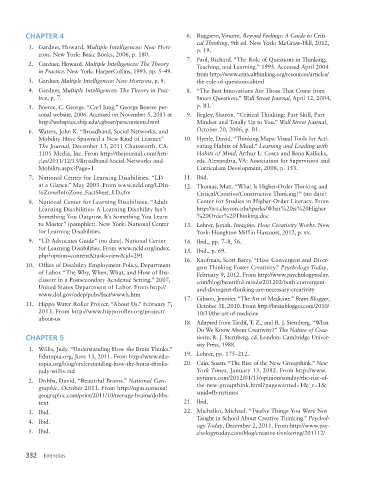Page 369 - Keys to College Success
P. 369
CHAPTER 4 6. Ruggiero, Vincent. Beyond Feelings: A Guide to Criti-
cal Thinking, 9th ed. New York: McGraw-Hill, 2012,
1. Gardner, Howard. Multiple Intelligences: New Hori- p. 19.
zons. New York: Basic Books, 2006, p. 180.
7. Paul, Richard. “The Role of Questions in Thinking,
2. Gardner, Howard. Multiple Intelligences: The Theory Teaching, and Learning.” 1995. Accessed April 2004
in Practice. New York: HarperCollins, 1993, pp. 5–49. from http://www. criticalthinking.org/resources/articles/
3. Gardner, Multiple Intelligences: New Horizons, p. 8. the-role-of-questions.shtml
4. Gardner, Multiple Intelligences: The Theory in Prac- 8. “The Best Innovations Are Those That Come from
tice, p. 7. Smart Questions.” Wall Street Journal, April 12, 2004,
5. Boeree, C. George. “Carl Jung.” George Boeree per- p. B1.
sonal website, 2006. Accessed on November 5, 2013 at 9. Begley, Sharon. “Critical Thinking: Part Skill, Part
http://webspace.ship.edu/cgboer/ perscontents.html Mindset and Totally Up to You.” Wall Street Journal,
6. Waters, John K. “Broadband, Social Networks, and October 20, 2006, p. B1.
Mobility Have Spawned a New Kind of Learner.” 10. Hyerle, David. “Thinking Maps: Visual Tools for Acti-
The Journal, December 13, 2011 Chatsworth, CA: vating Habits of Mind.” Learning and Leading with
1105 Media, Inc. From http://thejournal.com/Arti- Habits of Mind, Arthur L. Costa and Bena Kallicks,
cles/2011/12/13/Broadband-Social-Networks-and- eds. Alexandria, VA: Association for Supervision and
Mobility.aspx?Page=1 Curriculum Development, 2008, p. 153.
7. National Center for Learning Disabilities. “LD 11. Ibid.
at a Glance.” May 2003. From www.ncld.org/LDIn- 12. Thomas, Matt. “What Is Higher-Order Thinking and
foZone/InfoZone_FactSheet_LD.cfm Critical/Creative/Constructive Thinking?” (no date)
8. National Center for Learning Disabilities. “Adult Center for Studies in Higher-Order Literacy. From
Learning Disabilities: A Learning Disability Isn’t http://a-s.clayton.edu/tparks/What%20is%20Higher
Something You Outgrow. It’s Something You Learn %20Order%20Thinking.doc
to Master” (pamphlet). New York: National Center 13. Lehrer, Jonah. Imagine: How Creativity Works. New
for Learning Disabilities. York: Houghton Mifflin Harcourt, 2012, p. xx.
9. “LD Advocates Guide” (no date). National Center 14. Ibid., pp. 7–8, 56.
for Learning Disabilities. From www.ncld.org/index. 15. Ibid., p. 69.
php?option=content&task=view&id=291
16. Kaufman, Scott Barry. “How Convergent and Diver-
10. Office of Disability Employment Policy, Department gent Thinking Foster Creativity.” Psychology Today,
of Labor. “The Why, When, What, and How of Dis- February 9, 2012. From http://www.psychologytoday.
closure in a Postsecondary Academic Setting.” 2007, com/blog/beautiful-minds/201202/both-convergent-
United States Department of Labor. From http:// and-divergent-thinking-are-necessary-creativity
www.dol.gov/odep/pubs/fact/wwwh.htm
17. Gibson, Jennifer. “The Art of Medicine.” Brain Blogger,
11. Hippo Water Roller Project. “About Us.” February 7, October 31, 2010. From http://brainblogger.com/2010/
2013. From http://www.hipporoller.org/project/ 10/31/the-art-of-medicine
about-us
18. Adapted from Tardif, T. Z., and R. J. Sternberg. “What
Do We Know About Creativity?” The Nature of Crea-
CHAPTER 5 tivity, R. J. Sternberg, ed. London: Cambridge Univer-
sity Press, 1988.
1. Willis, Judy. “Understanding How the Brain Thinks.”
Edutopia.org, June 13, 2011. From http://www.edu- 19. Lehrer, pp. 175–212.
topia.org/blog/understanding-how-the-brain-thinks- 20. Cain, Susan. “The Rise of the New Groupthink.” New
judy-willis-md York Times, January 13, 2012. From http://www.
nytimes.com/2012/01/15/opinion/sunday/the-rise-of-
2. Dobbs, David. “Beautiful Brains.” National Geo-
graphic, October 2011. From http://ngm.national the-new-groupthink.html?pagewanted=1&_r=1&
geographic.com/print/2011/10/teenage-brains/dobbs- smid=fb-nytimes
text 21. Ibid.
3. Ibid. 22. Michalko, Michael. “Twelve Things You Were Not
Taught in School About Creative Thinking.” Psychol-
4. Ibid.
ogy Today, December 2, 2011. From http://www.psy-
5. Ibid. chologytoday.com/blog/creative-thinkering/201112/
332 Endnotes

